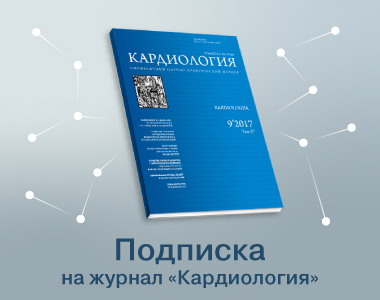Влияние уратснижающей терапии на долгосрочный прогноз после чрескожного коронарного вмешательства у пациентов с гиперурикемией
https://doi.org/10.18087/cardio.2025.8.n2942
Аннотация
Введение. Гиперурикемия (ГУ) часто сочетается с ишемической болезнью сердца (ИБС) и связана с неблагоприятными сердечно-сосудистыми исходами. Долгосрочное влияние уратснижающей терапии (УСТ) на клинические исходы, включая смертность от всех причин и основные неблагоприятные сердечно-сосудистые события (MACE), у пациентов с ИБС после чрескожного коронарного вмешательства (ЧКВ) не изучалось, что и явилось целью настоящего исследования.
Материал и методы. В ретроспективное когортное исследование было включено 649 пациентов с ГУ, перенесших ЧКВ в период с июля 2014 года по май 2020 года. Пациенты, получавшие стандартизированную УСТ не менее одного месяца после ЧКВ, были отнесены к группе лечения, а пациенты, не получавшие лечения или не соблюдавшие режим лечения, – к группе без лечения. Результаты оценивали с помощью кривых выживаемости Каплана–Майера, многофакторных регрессионных моделей Кокса и коэффициента соответствия. Оценивалась функция сердца до и после операции, включая фракцию выброса левого желудочка и систолическое давление в правом желудочке (СДПЖ).
Результаты. В течение медианного периода наблюдения (6,32 года), смертность от всех причин составила 30,41 на 1000 человеко-лет, а развитие MACE произошло с частотой 45,90 на 1000 человеко-лет. Уратснижающая терапия была связана со значительным снижением смертности от всех причин (отношение рисков [HR]: 0,915; 95% доверительный интервал [CI]: 0,645–0,998) и MACE (HR: 0,887; 95% CI: 0,661–0,990). Анализы подгрупп и чувствительности подтвердили эти преимущества независимо от исходных концентраций мочевой кислоты (МК) или ранней нормализации МК. В частности, УСТ была наиболее эффективна в снижении сердечно-сосудистой смертности и инфаркта миокарда, без существенного влияния на инсульт или сердечную недостаточность. Функция сердца в группе лечения улучшилась после ЧКВ, со значительным улучшением диастолической функции и СДПЖ. В анализе чувствительности с использованием коэффициента соответствия, защитный эффект УСТ как в отношении общей смертности, так и в отношении основных сердечно-сосудистых событий оставался устойчивым, что подтверждает выводы первичного анализа.
Заключение. Раннее начало УСТ у пациентов с гиперурикемией после ЧКВ связано с улучшением долгосрочной выживаемости, снижением частоты основных сердечно-сосудистых событий и улучшением функции сердца. Эти результаты подчеркивают клиническую ценность уратснижающей терапии.
Ключевые слова
Об авторах
Бэй ЧжаоКитай
MD, PhD
Пекин, Китай
Чжун Чжан
Китай
MD, PhD
Пекин, Китай
Чаошэн Ду
Китай
MS
Пекин, Китай
Нин Ли
Китай
MS
Пекин, Китай
Ли Лю
Китай
MS
Пекин, Китай
Сяобин Чжао
Китай
MS
Пекин, Китай
Шуай Мао
Китай
MD, PhD
Пекин, Китай
Хуэйхуэй Ся
Китай
Bachelor of Science in Nursing (BScN)
Пекин, Китай
Чанхуэй Дуо
Китай
Bachelor of Science (BSc)
Пекин, Китай
Шоули Ван
Китай
MD, PhD
Пекин, Китай
Список литературы
1. Joseph P, Leong D, McKee M, Anand SS, Schwalm J-D, Teo K et al. Reducing the Global Burden of Cardiovascular Disease, Part 1: The Epidemiology and Risk Factors. Circulation Research. 2017;121(6):677–94. DOI: 10.1161/CIRCRESAHA.117.308903
2. Liu S, Li Y, Zeng X, Wang H, Yin P, Wang L et al. Burden of Cardiovascular Diseases in China, 1990-2016: Findings From the 2016 Global Burden of Disease Study. JAMA Cardiology. 2019;4(4):342– 52. DOI: 10.1001/jamacardio.2019.0295
3. Doenst T, Thiele H, Haasenritter J, Wahlers T, Massberg S, Haverich A. The treatment of coronary artery disease – current status six decades after the first bypass operation. Deutsches Ärzteblatt international. 2022;119(42):716–23. DOI: 10.3238/arztebl.m2022.0277
4. Karády J, Taron J, Kammerlander AA, Hoffmann U. Outcomes of anatomical vs. functional testing for coronary artery disease: Lessons from the major trials. Herz. 2020;45(5):421–30. DOI: 10.1007/s00059-020-04950-y
5. Mal K, Jabar Ali JB, Fatima K, Rizwan A. Incidence of Hyperuricemia in Patients with Acute Myocardial Infarction – A Case-Control Study. Cureus. 2020;12(1):e6722. DOI: 10.7759/cureus.6722
6. Zuo T, Liu X, Jiang L, Mao S, Yin X, Guo L. Hyperuricemia and coronary heart disease mortality: a meta-analysis of prospective cohort studies. BMC Cardiovascular Disorders. 2016;16(1):207. DOI: 10.1186/s12872-016-0379-z
7. Yang L, Wei Q, Sun Y, Guo J, Xu X, Zhang Z et al. Hyperuricemia and coronary heart disease: The mediating role of blood pressure and thrombospondin 3. Nutrition, Metabolism and Cardiovascular Diseases. 2023;33(10):1969–80. DOI: 10.1016/j.numecd. 2023.06.001
8. Akashi N, Kuwabara M, Matoba T, Kohro T, Oba Y, Kabutoya T et al. Hyperuricemia predicts increased cardiovascular events in patients with chronic coronary syndrome after percutaneous coronary intervention: A nationwide cohort study from Japan. Frontiers in Cardiovascular Medicine. 2023;9:1062894. DOI: 10.3389/fcvm.2022.1062894
9. Hromadka M, Opatrny J, Miklik R, Suchy D, Bruthans J, Jirak J et al. Uricemia in the acute phase of myocardial infarction and its relation to long-term mortality risk. Journal of Comparative Effectiveness Research. 2021;10(12):979–88. DOI: 10.2217/cer-2021-0082
10. Zhang C, Jiang L, Xu L, Tian J, Liu J, Zhao X et al. Implications of Hyperuricemia in Severe Coronary Artery Disease. The American Journal of Cardiology. 2019;123(4):558–64. DOI: 10.1016/j.amjcard.2018.11.027
11. Mora-Ramírez M, Estevez-Garcia IO, Irigoyen-Camacho ME, Bojalil R, Gonzalez-Pacheco H, Amezcua-Guerra LM. Hyperuricemia on Admission Predicts Short-Term Mortality due to Myocardial Infarction in a Population with High Prevalence of Cardiovascular Risk Factors. Revista de Investigación Clínica. 2017;69(5):247–53. DOI: 10.24875/RIC.17002167
12. Tang X-F, He C, Zhu P, Zhang C, Song Y, Xu J-J et al. Hyperuricemia is Associated With 2- and 5-Year Adverse Outcomes in Patients With ST-Segment Elevation Myocardial Infarction Undergoing Percutaneous Coronary Intervention. Frontiers in Endocrinology. 2022;13:852247. DOI: 10.3389/fendo.2022.852247
13. Song X, Wang Y, Hou X, Che K, Wang R, Liu Y et al. Association between hyperuricemia and clinical adverse outcomes after percutaneous coronary intervention: A meta-analysis. International Journal of Cardiology. 2015;201:658–62. DOI: 10.1016/j.ijcard.2015.07.074
14. Tanaka A, Taguchi I, Hisauchi I, Yoshida H, Shimabukuro M, Hongo H et al. Clinical effects of a selective urate reabsorption inhibitor dotinurad in patients with hyperuricemia and treated hypertension: a multicenter, prospective, exploratory study (DIANA). European Journal of Medical Research. 2023;28(1):238. DOI: 10.1186/s40001-023-01208-1
15. Mackenzie IS, Hawkey CJ, Ford I, Greenlaw N, Pigazzani F, Rogers A et al. Allopurinol and cardiovascular outcomes in patients with ischaemic heart disease: the ALL-HEART RCT and economic evaluation. Health Technology Assessment. 2024;28(18):1–55. DOI: 10.3310/ATTM4092
16. Ma G, Li M, Teng W, He Z, Zhai X, Xia Z. Febuxostat combined with hydration for the prevention of contrast-induced nephropathy in hyperuricemia patients undergoing percutaneous coronary intervention: A CONSORT-compliant randomized controlled trial. Medicine. 2022;101(4):e28683. DOI: 10.1097/MD.0000000000028683
17. Sarhan II, Abdellatif YA, Saad RE, Teama NM. Renoprotective effect of febuxostat on contrast-induced acute kidney injury in chronic kidney disease patients stage 3: randomized controlled trial. BMC Nephrology. 2023;24(1):65. DOI: 10.1186/s12882-023-03114-4
18. Ma Y-C, Zuo L, Chen J-H, Luo Q, Yu X-Q, Li Y et al. Modified Glomerular Filtration Rate Estimating Equation for Chinese Patients with Chronic Kidney Disease. Journal of the American Society of Nephrology. 2006;17(10):2937–44. DOI: 10.1681/ASN.2006040368
19. Lawton JS, Tamis-Holland JE, Bangalore S, Bates ER, Beckie TM, Bischoff JM et al. 2021 ACC/AHA/SCAI Guideline for Coronary Artery Revascularization: A Report of the American College of Cardiology/American Heart Association Joint Committee on Clinical Practice Guidelines. Circulation. 2022;145(3):e18–114. DOI: 10.1161/CIR.0000000000001038
20. Chinese Medical Association, Chinese Society of Endocrinology. Guideline for the diagnosis and management of hyperuricemia and gout in China(2019). Chinese Journal of Endocrinology and Metabolism. 2020;36(1):1–13. DOI: 10.3760/cma.j.is sn.1000-6699.2020.01.001
21. Section of Interventional Cardiology, Chinese Society of Cardiology of Chinese Medical Association, Editorial Board of Chinese Journal of Cardiology. Chinese guideline for percutaneous coronary intervention (pocket guideline). Zhonghua Xin Xue Guan Bing Za Zhi. 2012;40(4):271–7. PMID: 22801302
22. Doehner W, Schoene N, Rauchhaus M, Leyva-Leon F, Pavitt DV, Reaveley DA et al. Effects of Xanthine Oxidase Inhibition With Allo purinol on Endothelial Function and Peripheral Blood Flow in Hyperuricemic Patients With Chronic Heart Failure: Results From 2 Placebo-Controlled Studies. Circulation. 2002;105(22):2619–24. DOI: 10.1161/01.CIR.0000017502.58595.ED
23. Qazi SU, Qamar U, Maqsood MT, Gul R, Ansari SA, Imtiaz Z et al. Efficacy of Allopurinol in Improving Endothelial Dysfunction: A Systematic Review and Meta-Analysis. High Blood Pressure & Cardiovascular Prevention. 2023;30(6):539–50. DOI: 10.1007/s40292-023-00615-z
24. Alem MM. Allopurinol and endothelial function: A systematic review with meta-analysis of randomized controlled trials. Cardiovascular Therapeutics. 2018;36(4):e12432. DOI: 10.1111/1755- 5922.12432
25. Britnell SR, Chillari KA, Brown JN. The Role of Xanthine Oxidase Inhibitors in Patients with History of Stroke: A Systematic Review. Current Vascular Pharmacology. 2018;16(6):583–8. DOI: 10.2174/1570161115666170919183657
26. Fang Y-J, Wu T-Y, Lin C-L, Su C-Y, Li J-R, Chung Y-L et al. Effects of Urate-Lowering Therapy on Risk of Hyperlipidemia in Gout by a Population-Based Cohort Study and on In Vitro Hepatic Lipogenesis-Related Gene Expression. Mediators of Inflammation. 2020;2020:8890300. DOI: 10.1155/2020/8890300
27. Wu J, Zhang Y, Qu Y, Jie L, Deng J, Yu Q. Efficacy of uric acid-lowering therapy on hypercholesterolemia and hypertriglyceridemia in gouty patients. International Journal of Rheumatic Diseases. 2019;22(8):1445–51. DOI: 10.1111/1756-185X.13652
28. Nishino M, Egami Y, Nakamura H, Ukita K, Kawamura A, Matsuhiro Y et al. Prospective randomized comparison of effect on coronary endothelial and renal function between febuxostat and benzbromarone in hyperuricemic patients with coronary artery disease: EFEF study. Health Science Reports. 2022;5(2):e563. DOI: 10.1002/hsr2.563
29. Hays AG, Iantorno M, Schär M, Lai S, Czarny M, Breton E et al. The influence of febuxostat on coronary artery endothelial dysfunction in patients with coronary artery disease: A phase 4 randomized, placebo-controlled, double-blind, crossover trial. American Heart Journal. 2018;197:85–93. DOI: 10.1016/j.ahj.2017.11.006
30. Nakata T, Ikeda S, Koga S, Yonekura T, Tsuneto A, Doi Y et al. Randomized, Open-Label, Cross-Over Comparison of the Effects of Benzbromarone and Febuxostat on Endothelial Function in Patients with Hyperuricemia. International Heart Journal. 2020;61(5):984– 92. DOI: 10.1536/ihj.20-114
31. Tai C, Wu C, Lee K, Tseng T, Wang H, Chang F et al. The Impact of Urate-Lowering Therapy in Post-Myocardial Infarction Patients: Insights From a Population-Based, Propensity Score-Matched Analysis. Clinical Pharmacology & Therapeutics. 2022;111(3):655–63. DOI: 10.1002/cpt.2473
32. Kermani-Alghoraishi, MD M, Sanei H, Heshmat-Ghahdarijani K, Ghahramani R, Honarvar M, Sadeghi M. Impact of Allopurinol Pretreatment on Coronary Blood Flow and Revascularization Outcomes after Percutaneous Coronary Intervention in Acute STEMI Patients: A Randomized Double Blind Clinical Trial. ARYA Atherosclerosis Journal. 2023;19(6):1–9. DOI: 10.48305/arya.2023.11577.2121
Рецензия
Для цитирования:
Чжао Б., Чжан Ч., Ду Ч., Ли Н., Лю Л., Чжао С., Мао Ш., Ся Х., Дуо Ч., Ван Ш. Влияние уратснижающей терапии на долгосрочный прогноз после чрескожного коронарного вмешательства у пациентов с гиперурикемией. Кардиология. 2025;65(8):71-81. https://doi.org/10.18087/cardio.2025.8.n2942
For citation:
Zhao B., Zhang Zh., Du Ch., Li N., Liu L., Zhao X., Mao Sh., Xia H., Duo Ch., Wang Sh. Impact of Urate-Lowering Therapy after Percutaneous Coronary Intervention on the Long- Term Prognosis of Patients with Hyperuricemia. Kardiologiia. 2025;65(8):71-81. https://doi.org/10.18087/cardio.2025.8.n2942
















